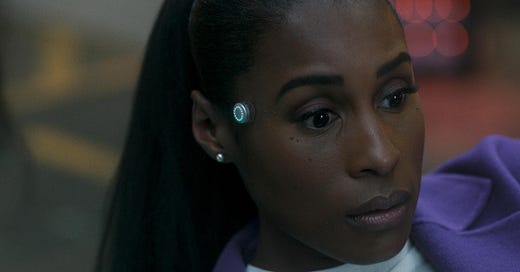'Black Mirror' Offers Sequels and Fresh Horrors in New Season
Show creator Charlie Brooker continues to find brilliant and inventive ways to warn us about the dangers lurking behind the new technology that's taking our lives.
Ah, the 2010s — that innocent time when social media was just beginning to dominate communication and we were still somewhat naive about how evil it could be. That’s when season 1 of the sci-fi-horror-drama anthology series Black Mirror first premiered. Now well over a decade into the show about the terrifying ways new technology can shape our lives, we’ve already seen its dangers, know that worse is coming and that our tech overlords delight in causing us pain. With all this chaos in reality, what’s left for Black Mirror to say?
Though show creator Charlie Brooker was kind enough to take a break from new seasons at the beginning of the COVID-19 pandemic in 2020 — we were depressed enough as it was — the shitshow that is the second Trump administration has not deterred Brooker’s season 7, which is now streaming on Netflix. And, with the exception of the few bright spots that most seasons boast, the show is as bleak as ever. Though it digs in its own backyard for many of the episodes — there are sequels and spiritual sequels to fan-favorite episodes this season — Brooker still has some fresh horrors up his sleeve.
The first three episodes this season feature Black actresses in lead roles: “Common People” with Rashida Jones and Tracee Ellis Ross; “Bête Noire” with Siena Kelly and “Hotel Reverie” with Issa Rae.
“Common People” is the most brutal of the season and features Jones (co-writer of the popular “Nosedive” episode in season 3) returning to the series as Amanda, a happily married elementary school teacher. After she suffers an abrupt medical emergency, her husband (Chris O’Dowd) learns that his wife has a brain tumor and is essentially brain dead.
Enter Ross in her most evil role to date, as a sales rep for a “miracle” brain procedure from a company called Rivermind that will bring Amanda back to life. The distraught husband easily agrees, the surgery is a success and Amanda is back like nothing happened. Except now, her frontal lobe is connected to the Rivermind mainframe, which requires a previously undisclosed $300 monthly subscription to keep her alive. It’s a stretch for the working-class couple, but with extra shifts, they pull it off, until Rivermind makes new subscription tiers that they can’t afford, leaving Amanda on the new “common” tier, unknowingly spouting ads Rivermind is feeding into her brain. A horrifying commentary on our all-too-fucked health “care” system, “Common People” shows the new ways our subscription-obsessed tech overlords will make us pay to stay alive and why so many desperate people continue to feel that it’s easier to just opt out.
The next and most triggering of the season is “Bête Noire” (which translates to “black beast” in French, and I don’t know how to feel about that!). Kelly plays Maria, a Black woman on the rise at a food development company when her former white high school classmate Verity lands a role at her job. A victim of Maria’s bullying back in school, Verity seems out for revenge and, in a matter of days on the job, has turned Maria’s entire world against her. A metaphor for how white women’s tears can literally change Black people’s reality, “Bête Noire” is gaslighting at its finest, with Brooker showing viewers two different versions of the episode, so we can gaslight each other and ourselves online about what we saw (“Is the fast-food chain Maria’s boyfriend works at called Barnie’s or Bernie’s?” Congrats to the eagle-eyed fan who spotted the restaurant in the background of the season 3 episode “Hang the DJ” and confirmed, in the Black Mirror universe, the chain is called Barnie’s, despite Brooker’s clever trick.) Trigger-warning: The white woman calls the police on Maria, frames her with a knife and then a gun, hoping that the police kill her. Whew, that’s too much reality for me.
The most promising episode is Rae’s “Hotel Reverie.” She plays Brandy, an actress who is professionally and personally stuck, pigeon-holed by Hollywood into either the indie Black trauma lead or the sexy blockbuster sidekick. When a failing classic movie studio partners with an AI company to remake old movies with modern stars through virtual reality, Brandy jumps at the opportunity to take on the lead role of Alex, formerly played by a white male. The trick is to digitally render her into the scenes with AI versions of the film’s characters. When a computer accident leaves Brandy trapped in character with her AI leading lady, the self-actualizing avatar of closeted queer actress Dorothy (Emma Corrin), she and Brandy fall tragically in love — just like in the movie — until the servers come back online again and Dorothy’s memory is wiped.
Fans are comparing “Hotel Reverie” to the other Black Mirror sapphic romance and one of the show’s best episodes: season 3’s “San Junipero.” It’s a comparison creator Charlie Brooker has invited, not just because it’s the other VR lesbian love story in the show; Brandy also lives on a street named Junipero. While the episodes may be on the same street, they’re in different counties. Not only does “San Junipero” have the rare Black Mirror happy ending, its leads, Gugu Mbatha-Raw and Mackenzie Davis, have an instant chemistry that builds across the episode’s timeline. Brandy and Dorothy’s love story has a tragic ending, and Rae and Corrin don’t have Mbatha-Raw and Davis’ electric chemistry. And when Brandy makes no effort to act like she’s in the 1940s — no transatlantic accent, no intonation in the voice, no leading man swagger when Alex’s impeccably tailored suits and sleek ponytail render around her digital form, “Hotel Reverie” is not making the case that Brandy has been unfairly pigeon-holed.
The series standout is Paul Giamatti’s heartbreaking performance in “Eulogy,” as a bitter, middle-aged man who finds out the love of his life from his twenties has just recently died. He’s asked to give a eulogy, but he was so devastated by that breakup in his twenties that he’s essentially erased her from his mind and scratched out her face from the photos he didn’t burn. The eulogy is a ploy to introduce him to a new VR technology that allows him to digitally enter the photographs he took during their time together and walk around in his old shoes, piecing together and relitigating what went right and what went terribly wrong in that relationship. A spiritual sequel to season 1’s “The History of You,” where a depressed man replays video in his head of his wife leaving him, “Eulogy” offers up the closure and peace that can come from reliving one’s life through photographs, and maybe — with the help of hindsight and time — seeing the truth in a new light.
The weakest episodes are exposition-filled: “Plaything” which continues the story from the timeline of the weak and forgettable interactive standalone episode “Bandersnatch,” and “USS Callister: Into Infinity,” which is the sequel to season 4’s incredible premiere episode “USS Callister.” The season 4 episode was so thrilling and ended so perfectly that I’m just going to pretend like season 7’s utterly unnecessary and ultimately unfulfilling “Into Infinity” doesn’t exist.
Sure, Brooker reheated his own nachos several times this season. And even though there were more softer endings, if not all-out happy ones, in this season than usual, perhaps we still could’ve used another COVID reprieve; the pandemic (on top of everything else) is still going on, after all. But Brooker continues to find brilliant, inventive and intriguing ways to warn us about the impending doom that is our near-future; and the way my anxiety is set up, I simply refuse to pass up a sneak peak at what’s coming.






